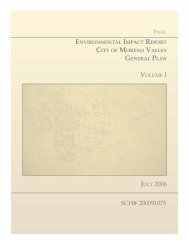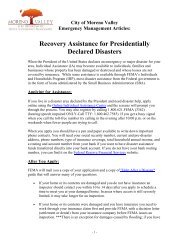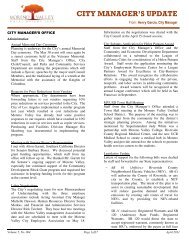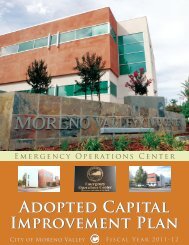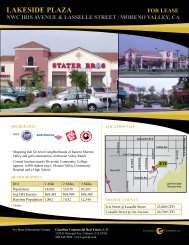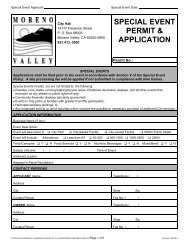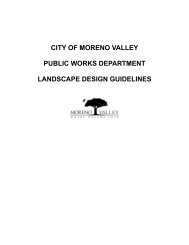Community Forum: World Logistics Center CEQA Process & EIR ...
Community Forum: World Logistics Center CEQA Process & EIR ...
Community Forum: World Logistics Center CEQA Process & EIR ...
Create successful ePaper yourself
Turn your PDF publications into a flip-book with our unique Google optimized e-Paper software.
<strong>Community</strong> <strong>Forum</strong>:<br />
<strong>World</strong> <strong>Logistics</strong> <strong>Center</strong><br />
<strong>CEQA</strong> <strong>Process</strong> & <strong>EIR</strong> Overview<br />
February 25, 2013<br />
Dr. Michael Brandman, Ph.D. – Director<br />
First Carbon Solutions | Michael Brandman Associates
Rules and Regulations<br />
• The Statute<br />
Public Resources Code §§ 21000-21178<br />
(PRC)<br />
• The Guidelines<br />
California Code of Regulations Title 14,<br />
§15000 et seq. (CCR)
<strong>CEQA</strong> Lingo<br />
<strong>CEQA</strong>: California Environmental Quality Act<br />
IS: Initial Study<br />
ND: Negative Declaration<br />
NOP: Notice of Preparation of <strong>EIR</strong><br />
<strong>EIR</strong>: Environmental Impact Report<br />
D<strong>EIR</strong>: Draft <strong>EIR</strong><br />
F<strong>EIR</strong>: Final <strong>EIR</strong><br />
NOC: Notice of Completion<br />
NOD: Notice of Determination<br />
NOA: Notice of Availability
Introduction to <strong>CEQA</strong><br />
• 1969: President Nixon signs National<br />
Environmental Policy Act (NEPA)<br />
• 1970: Governor Reagan signs California<br />
Environmental Quality Act (<strong>CEQA</strong>)<br />
• <strong>CEQA</strong> (the Statute): Established by<br />
Legislature<br />
. . . and continuously modified by Legislature<br />
. . . and “interpreted” by the Courts
Introduction to <strong>CEQA</strong> (cont.)<br />
• Initially intended to apply to publiclysponsored<br />
projects only<br />
• 1972: Friends of Mammoth v. Board of<br />
Supervisors:<br />
<strong>CEQA</strong> applies to ‘all’ projects subject to public<br />
agency discretionary action
Who is “in charge” of <strong>CEQA</strong>?<br />
• Lead Agency<br />
• <strong>CEQA</strong> is a “Self-executing Statute” meaning it is<br />
the Lead-Agency’s duty to determine what is and<br />
is not subject to <strong>CEQA</strong>, and to follow the process.<br />
• Public can go through the legal process to<br />
challenge decisions
Basic Purposes of <strong>CEQA</strong><br />
1. Inform government decision makers and<br />
the public about the potential significant<br />
environmental impacts of proposed<br />
activities.<br />
2. Identify ways that potential significant<br />
environmental impact(s) can be avoided<br />
or significantly reduced.
Basic Purposes of <strong>CEQA</strong> (cont.)<br />
3. Prevent significant avoidable damage to the<br />
environment by requiring changes in the<br />
project through the use of alternatives and<br />
mitigation<br />
4. Disclose to the public the reason that an<br />
agency approved a project notwithstanding<br />
its environmental impacts<br />
5. It is not a marketing or advocacy document
The <strong>CEQA</strong><br />
<strong>Process</strong>
You are<br />
Here!
<strong>CEQA</strong> <strong>Process</strong> Overview<br />
• An action is brought forth to the Lead Agency<br />
• Is it a “project” or is it “exempt”?<br />
• If subject to <strong>CEQA</strong>, what are the potential impacts?<br />
(prepare an Initial Study)<br />
• Based on initial study, what type of <strong>CEQA</strong> document<br />
do you need? (Neg Dec, MND, <strong>EIR</strong>?)<br />
• Prepare appropriate environmental document<br />
• Public reviews and comments on document<br />
• Decision and findings made on the project
What is a “project” under <strong>CEQA</strong>?<br />
• Comply with <strong>CEQA</strong> when you have a<br />
“project.”<br />
• Project: activity undertaken by a public<br />
agency or a private activity which may cause a<br />
change in the environment and must receive<br />
discretionary approval from a government<br />
agency.
Discretionary vs. Ministerial Projects<br />
• Discretionary projects (<strong>CEQA</strong>)<br />
Tentative maps<br />
General plans/Amendments<br />
Specific plans/Zone changes<br />
Conditional use permits<br />
• Ministerial projects (no <strong>CEQA</strong>)<br />
Demolition permits<br />
Building permits
Typical <strong>CEQA</strong> Projects<br />
• Residential<br />
• Commercial/Industrial<br />
• Transportation<br />
• Water and Energy Infrastructure
Exemptions to <strong>CEQA</strong><br />
• Statutory<br />
Activities exempted from all or part of <strong>CEQA</strong><br />
by the State Legislature regardless of impacts<br />
(policy decision)<br />
• Categorical<br />
Classes of projects which are exempted from<br />
<strong>CEQA</strong> because they typically do not have<br />
significant impacts (there are exceptions)
Statutory Exemption Examples<br />
Article 18<br />
• 1984 L.A. Olympic games<br />
• Family day care homes<br />
• Specified mass transit projects<br />
• State and regional transportation improvement programs<br />
• Projects located outside California<br />
• Certain pipeline work<br />
• Air quality permits<br />
• Ministerial projects<br />
• Emergency projects<br />
• Other miscellaneous per CCR §15282
Categorical Exemptions<br />
Article 19<br />
• Classes of projects that do not have a significant<br />
impact on the environment<br />
• Not applicable when cumulative impact is significant<br />
or when there is a potential significant impact due to<br />
unusual circumstances<br />
Scenic highways<br />
Hazardous waste sites<br />
Historical resources
Categorical Exemptions<br />
• Existing facilities<br />
• Reconstruction<br />
• Small structures<br />
• Minor alterations to land or<br />
land use<br />
• Actions by regulatory<br />
agencies for natural<br />
resources protection or<br />
protection of the<br />
environment<br />
• Surplus property sales<br />
• Land acquisition for wildlife<br />
conservation<br />
• Minor additions to school<br />
• Minor land divisions<br />
• Transfer of ownership for<br />
parks<br />
• Total of 33 categories outlined<br />
in section 15301 of Guidelines
Initial Study<br />
• Purpose<br />
Complete a project description<br />
To decide between a Negative Declaration,<br />
Mitigated Negative Declaration, or <strong>EIR</strong><br />
Refine issues to be addressed in an <strong>EIR</strong><br />
• Initial Study is not required if it is known an <strong>EIR</strong> will<br />
be prepared
Contents of Initial Studies<br />
CCR §15063(d)<br />
• Project description - location, project objectives and<br />
characteristics<br />
• Environmental setting<br />
• Discussion of environmental impacts using Appendix<br />
G checklist<br />
• Mitigation measures if necessary<br />
• List of preparers
Checklist topics<br />
• Aesthetics<br />
• Agriculture<br />
• Air Quality (GHG)<br />
• Biology<br />
• Cultural<br />
• Geology<br />
• Hazards<br />
• Hydrology<br />
• Land Use<br />
• Minerals<br />
• Noise<br />
• Population/Housing<br />
• Public Services/Utilities<br />
• Recreation<br />
• Transportation/traffic<br />
• Urban decay
Appendix G Checklist
Definition of<br />
“Significant Impact on the Environment”<br />
• Substantial, or potentially substantial, adverse<br />
change in any of the physical conditions within<br />
the area affected by the project including land,<br />
air, water, minerals, flora, fauna, ambient<br />
noise, and objects of historic or aesthetic<br />
significance. A social or economic change by<br />
itself shall not be considered a significant<br />
effect on the environment (CCR §15382)
After the checklist . . .<br />
• The IS checklist will help you determine<br />
what type of <strong>CEQA</strong> environmental<br />
document the Lead Agency will need to<br />
prepare (or have prepared for them)
When to Prepare an <strong>EIR</strong><br />
• Substantial evidence in the record supports a fair<br />
argument that significant impacts may occur.<br />
• Fair Argument – Very Low Threshold<br />
If there is any substantial evidence to support a fair<br />
argument that project may have significant<br />
environmental impacts, an <strong>EIR</strong> must be prepared<br />
There is a presumption in <strong>CEQA</strong> in favor of preparing<br />
<strong>EIR</strong>s instead of Neg Decs
Basic Types of <strong>EIR</strong>s<br />
• Project <strong>EIR</strong><br />
• Program <strong>EIR</strong> for The <strong>World</strong> Logistic <strong>Center</strong><br />
• Tiered <strong>EIR</strong><br />
• Subsequent/Supplemental<br />
• Focused <strong>EIR</strong><br />
• Addendum <strong>EIR</strong>
<strong>EIR</strong> Versions<br />
• Administrative Draft <strong>EIR</strong> (not public)<br />
• Draft <strong>EIR</strong> (public review)<br />
• Final <strong>EIR</strong>
<strong>EIR</strong> <strong>Process</strong> Overview<br />
• Notice of Preparation (NOP) released for 30 days<br />
• Scoping meeting<br />
• Notice of Completion (NOC) and Notice of Availability<br />
(NOA) to start minimum 45-day Draft <strong>EIR</strong> public review –<br />
60 days for WLCP<br />
• Responses to comments sent to responding public agencies<br />
10 days before <strong>EIR</strong> certification<br />
• Public hearing generally held for discretionary approval<br />
• <strong>EIR</strong> certification, project approval, <strong>CEQA</strong> findings,<br />
statement of overriding considerations<br />
• File Notice of Determination (NOD)
<strong>World</strong> <strong>Logistics</strong> <strong>Center</strong> Program <strong>EIR</strong><br />
• General Plan Amendment (3,814 acres)<br />
• Specific Plan (2,710 acres)<br />
• Tentative Parcel Map (Financing Purposes only)<br />
• Development Agreement<br />
• 41.6 million square feet of logistics warehouse<br />
facilities<br />
• Associated Infrastructure<br />
• Much, much more
Notice of Preparation (NOP)<br />
Include:<br />
Description, location, and a discussion<br />
of the probable environmental effects.<br />
<strong>EIR</strong> can be initiated while waiting for<br />
comments<br />
Responsible agencies and public have<br />
30 days to comment on an NOP.<br />
The comments should to be addressed<br />
in the <strong>EIR</strong>.<br />
<strong>EIR</strong> cannot be released for public<br />
review until 30 days after distribution of<br />
the NOP.
Scoping <strong>Process</strong><br />
• During these 30 days, a scoping meeting<br />
may be held to identify key environmental<br />
concerns and issues<br />
Identify possible impacts<br />
Encourage inter-agency consultation<br />
Consult with recognized experts<br />
Involve public at an early stage of the review<br />
process (though not required)
What needs to be in the <strong>EIR</strong>?<br />
• Project description<br />
• Environmental Setting<br />
• Significant environmental effects<br />
• Unavoidable significant adverse effects<br />
• Growth-inducing impacts<br />
• Cumulative impacts<br />
• Mitigation measures<br />
• Alternatives<br />
• F<strong>EIR</strong> contains response to comments
Mitigation Measures<br />
• Required for all potentially significant impacts if possible<br />
• Should identify who, what, where and when<br />
• Be legally, technically, socially, politically and<br />
economically feasible<br />
• Should avoid the impact altogether or minimize impacts<br />
by limiting the magnitude<br />
• May rectify by repairing, rehabilitating, restoring<br />
• May reduce or eliminate over time<br />
• May compensate by replacing or providing substitute<br />
resources
WLCP <strong>EIR</strong> Impact Analysis Issues<br />
• Aesthetics<br />
• Agriculture and Forest Resources<br />
• Air Quality<br />
• Biological Resources<br />
• Cultural Resources<br />
• Geology and Soils<br />
• Greenhouse Gas Emissions and<br />
Global Climate Change<br />
• Hazards and Hazardous<br />
Materials<br />
• Hydrology and Water Quality<br />
• Land Use and Planning<br />
• Mineral Resources<br />
• Noise<br />
• Population, Housing, and<br />
Employment<br />
• Public Services including<br />
Recreation<br />
• Traffic and Circulation<br />
• Utilities and Service Systems
Technical Studies<br />
• Help provide supporting evidence for the<br />
<strong>CEQA</strong> documents<br />
• Useful to see what checklist questions the<br />
consultant or planner is using, and tailor<br />
your report to answering those questions<br />
• Specific project design features, often to<br />
comply with mitigation measures<br />
• Technical experts often called to give<br />
testimony at public hearing
WLCP Technical Studies<br />
• “The <strong>World</strong> <strong>Logistics</strong> <strong>Center</strong> Specific Plan” (Highland Fairview).<br />
• “An Agricultural Industry Analysis of the Inland Empire”<br />
(Andrew Chang & Company, LLC).<br />
• “Agricultural Resources Assessment for the WLCSP” (Parsons<br />
Brinckerhoff).<br />
• “Air Quality, Greenhouse Gas, and Health Risk Assessment for the<br />
WLCSP” (MBA).<br />
• “Habitat Assessment, MSHCP Consistency Analysis, and HANS Review”<br />
(MBA).<br />
• “Delineation of Jurisdictional Waters and Wetlands” (MBA).<br />
• “Phase I and Phase II Cultural Resources Assessment” (MBA).<br />
• “Preliminary Geotechnical Investigation” (Leighton).<br />
• “Supplemental Geotech Assessment for Offsite Improvements Related to<br />
the WLCSP” (Leighton).<br />
• “Phase 1 Environmental Site Assessments” (various, LOR Geotechnical).
WLCP Technical Studies (cont.)<br />
• “Draft Master Plan of Drainage Study” (CH2MHill).<br />
• “Preliminary Water Quality Management Plan” (CH2MHill).<br />
• “Noise Assessment for the WLCSP” (Mestre Greve Associates).<br />
• “Traffic Impact Assessment (TIA) for the WLCSP” (Parsons Brinckerhoff).<br />
• “NAIOP Assessment of Available High-Cube Trip Generation Rates” (Kunzman<br />
Associates).<br />
• “Water Supply Assessment for the WLCSP” (Eastern Municipal Water District).<br />
• “Highlands Water Budget” (CH2MHill).<br />
• “Water System Modeling Results” (CH2MHill).<br />
• “Sewer and Reclaimed Wastewater Memorandum” (CH2MHill).<br />
• “Dry Utilities – Technical Memorandum” (Utility Specialists).<br />
• “Electrical System Forecast of Utility Infrastructure” (MVU Engineering).<br />
• “Fiscal and Economic Impact Study” (David Taussig and Associates).
WLCP <strong>EIR</strong> Challenges<br />
• Loss of Views<br />
• Air Pollutant Emissions<br />
• Indirect Impact of Wildlife<br />
• Potential loss of Cultural Resources<br />
• Geologic Faults<br />
• Greenhouse Gas Emissions and Climate Change<br />
• Water Related Impacts<br />
• Loss of Affordable Housing Opportunity<br />
• Noise Impacts<br />
• Truck Traffic Impacts
When the D<strong>EIR</strong> is Complete:<br />
• Issue Public Notice of Availability (NOA)<br />
Mailed to those previously requesting notice<br />
and,<br />
General circulation newspaper or,<br />
Posting in the project area or,<br />
Direct mailing to owners/occupants of<br />
contiguous parcels
Issue Notice of Completion<br />
(NOC)<br />
Sent to SCH<br />
Brief description of project<br />
Location<br />
Address where environmental<br />
document is available<br />
Notice of hearings<br />
(if one is scheduled)<br />
Begins the 45-day public<br />
review period; 60 days for<br />
WLCP D<strong>EIR</strong>
Final <strong>EIR</strong><br />
• Includes text revisions to Draft <strong>EIR</strong><br />
• Includes responses to comments<br />
• No separate public review period<br />
• Written response to commenting agencies<br />
10 days prior to certification
Final Decision <strong>Process</strong><br />
1. Consider and Certify <strong>EIR</strong><br />
2. Approve or Deny Project<br />
Make Findings<br />
Adopt Mitigation, Monitoring Program<br />
Adopt Statement of Overriding Considerations (if<br />
necessary)
Findings of Fact<br />
• Explicit Requirements to projects with significant<br />
environmental impacts<br />
• Agency should not approve projects if feasible alternatives<br />
or mitigation measures that would lessen significant<br />
environmental effects unless:<br />
1. Changes or alterations to mitigate significant environmental impacts<br />
2. Such changes responsibility of another agency<br />
3. Specific economic, social, or other considerations make the mitigation<br />
measures or alternatives infeasible<br />
• Must adopt findings identifying the specific considerations<br />
that make infeasible the environmentally systems<br />
alternative
Statement of Overriding Considerations<br />
• Approval of projects with significant environmental impacts<br />
• Economic, social, or other considerations make it infeasible<br />
to fully mitigate<br />
• Must adopt statement of overriding considerations,<br />
although adverse impacts, specific overriding economic,<br />
legal, social, technological, or other considerations<br />
outweigh projects significant, un-mitigated impacts<br />
• Often tied to project objectives in the <strong>EIR</strong><br />
• Supported by substantial evidence in the record
Final <strong>CEQA</strong> Step: Notice of<br />
Determination (NOD)<br />
• Filed within 5 working days after project<br />
approval<br />
• Posted with the county clerk and State<br />
Clearinghouse for at least 30 days
Notice of Determination (NOD)<br />
Project description<br />
Location<br />
Date of approval<br />
Determination whether will have<br />
a significant effect on the<br />
environment<br />
That ND/MND or <strong>EIR</strong> was<br />
prepared/certified<br />
pursuant to <strong>CEQA</strong><br />
Whether mitigation measures are<br />
a condition and whether<br />
Statement of Overriding<br />
Considerations was adopted<br />
Address of where ND/MND or<br />
<strong>EIR</strong> and certification can be<br />
examined
Helpful Websites<br />
<strong>CEQA</strong> Statute and Guidelines<br />
http://ceres.ca.gov/ceqa/<br />
Land Use Planning Information Network (LUPIN)<br />
http://ceres.ca.gov/planning/index.html<br />
California Association of Environmental<br />
Professionals (AEP)<br />
http://www.califaep.org/
FirstCarbon Solutions | Michael Brandman Associates<br />
Environmental Services ☼ Planning ☼<br />
Natural Resources Management<br />
Dr. Michael Brandman, Ph.D.<br />
Director<br />
220 Commerce, Suite 200<br />
Irvine, CA 92602<br />
Office: 714.508.4100<br />
Mobile: 714.7742.5300<br />
Email: MBrandman@brandman.com<br />
www.firstcarbonsolutions.com




